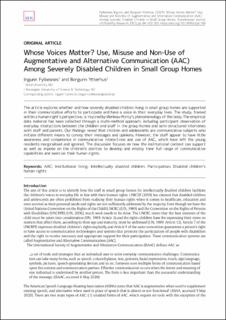| dc.contributor.author | Fylkesnes, Ingunn | |
| dc.contributor.author | Ytterhus, Borgunn | |
| dc.date.accessioned | 2021-04-20T10:10:24Z | |
| dc.date.available | 2021-04-20T10:10:24Z | |
| dc.date.created | 2021-04-15T08:51:48Z | |
| dc.date.issued | 2021 | |
| dc.identifier.citation | Scandinavian Journal of Disability Research. 2021, 23 (1), 94-103. | en_US |
| dc.identifier.issn | 1501-7419 | |
| dc.identifier.uri | https://hdl.handle.net/11250/2738598 | |
| dc.description.abstract | The article explores whether and how severely disabled children living in small group homes are supported in their communicative efforts to participate and have a voice in their everyday lives. The study, framed within a human right’s perspective, is inspired by Merleau-Ponty’s phenomenology of the body. The empirical data material has been collected through a multi-method approach, including participant observation of everyday interactions between the children and staff in the group homes and semi-structured interviews with staff and parents. Our findings reveal that children and adolescents are communicative subjects who initiate different means to convey their messages and opinions. However, the staff appear to have little awareness and competence in communicative interactions and use of AAC, which have left the young residents marginalised and ignored. The discussion focuses on how the institutional context can support as well as impede on the children’s abilities to develop and employ their full range of communicative capabilities and exercise their human rights. | en_US |
| dc.language.iso | eng | en_US |
| dc.publisher | Stockholm University Press | en_US |
| dc.rights | Navngivelse 4.0 Internasjonal | * |
| dc.rights.uri | http://creativecommons.org/licenses/by/4.0/deed.no | * |
| dc.title | Whose voices matter? Use, misuse and non-use of augmentative and alternative communication (AAC) among severely disabled children living in small group homes. | en_US |
| dc.type | Peer reviewed | en_US |
| dc.type | Journal article | en_US |
| dc.description.version | publishedVersion | en_US |
| dc.source.pagenumber | 94-103 | en_US |
| dc.source.volume | 23 | en_US |
| dc.source.journal | Scandinavian Journal of Disability Research | en_US |
| dc.source.issue | 1 | en_US |
| dc.identifier.doi | http://doi.org/10.16993/sjdr.748 | |
| dc.identifier.cristin | 1904204 | |
| cristin.ispublished | true | |
| cristin.fulltext | original | |
| cristin.qualitycode | 1 | |

